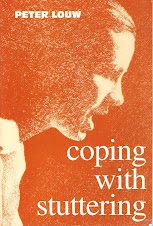The following tricks and speaking styles, used by many persons who stutter (PWS) to avoid stuttering, actually point toward the vocal folds (a.k.a. vocal cords) being a major culprit in stuttering:
Swallowing before speaking. Many PWSs have discovered that they won’t stutter immediately after swallowing. In the movie The King’s Speech, the actor Colin Firth as King George VI swallowed quite a lot before trying to speak (thus showing how well this actor prepared for the role as a PWS).
The explanation for the ability to speak fluently immediately after swallowing is that the vocal folds move closer together as you swallow, in order to keep food out of the air passage. After swallowing the vocal folds reopen automatically so that normal breathing can resume. The PWS uses this normal opening reflex, this "window of opportunity", to neutralise any possible abnormal vocal fold locking which could otherwise fire the conditioned stuttering reflex.
Speaking on the last remnants of air. It is a physical fact that the vocal folds widen as a first step in the process of breathing in. Some PWS use this phenomenon to avoid a stutter. They only begin speaking when they have nearly exhausted the air in their lungs. As the last air leaves the lungs, the vocal folds begin to widen. That’s the exact time, the window of opportunity, when the PWS starts speaking, as the wide position of the folds make it more difficult for them to lock.
Coughing before speaking. A cough forcibly and momentarily widens the vocal folds. This momentary wide open position of the folds is another "fluency window" for the PWS if he speaks immediately after the cough.
Speaking loudly or shouting. Speaking loudly or shouting also physically forces the vocal folds wide open, so reducing the possibility that they will lock and result in a stutter.
Speaking softly. Though shouting or speaking loudly can force the folds open, speaking softly can paradoxically also improve fluency, as soft speech reduces the physical tension on the (muscles of the) vocal folds. Soft speech is, of course, not really a "trick" - it's a way of speaking, but should be part of stuttering management. As an anti-stuttering device it does have its drawbacks, however, as it is not always practical to speak softly.
Slow start. The slower you begin speaking, the less physical tension on the vocal folds. Because of this phenomenon, a slow start has become an established fluency technique. Try slowing down the first syllable of each utterance and note the difference in your fluency!
Whispering, or speaking with a strange accent or in a different tone, or singing. The vocal folds apparently are in a more open position when a person speaks with a strange accent or in a different tone, or begins to sing. This reduces the likelihood that the folds will lock. When whispering there is no phonation (vocal fold vibration) - the folds do not come together and vibrate, so they can't lock.
Speaking after using a starter sound. Starter sounds can be “eeh” or “well”, “mmm” etc. These sounds are socially acceptable and are not regarded as stuttering by the non-stuttering public. For the PWS, however, these sounds play an important role as they are non-tension sounds (on which the PWS usually does not stutter) that initiate speech. Starting to speak is when stuttering most often occurs, so the starter sound acts as a safe ‘bridgehead’ in order to start speaking without stuttering.
This is how starters work: The starter sound initiates vocal fold vibration (also known as phonation – the production of sound). When the vocal folds are already vibrating, the chances that they will lock are reduced. They usually only tend to lock if they, while in a non-vibrating state, have to produce sound.
The above tricks and speaking styles are consistent with the hypothesis that stuttering is conditioned (learned) struggle behaviour in response to an unnatural, tension-related locking of the vocal folds. Doesn’t it all make sense? This hypothesis seems to be the most logical to explain stuttering.
Of course there are many other tricks, such as the so-called secondary behaviours - blinking an eye, stamping a foot etc. Secondaries work in another way: they distract your mind away from the stutter, so by-passing the conditioned stuttering reflex. The problem with secondaries is that they can become a habit (a conditioned reflex) themselves, and therefore part of the stuttering problem. In time they lose their distracting power and become just another useless part of stuttering behaviour.
Note that these tricks and speaking styles are not 100% foolproof. For instance, some people can stutter even while singing or whispering. It is all a matter of degree and of precise timing. The vocal folds operate extremely rapidly, and whether they lock or not will depend on fractions of a second and fractions of millimeters, and perhaps also on the intensity of these locks, depending on the individual and on tension levels.







thanks for these awesome tricks! Biggest help is just talk slowly, and "sing" a little bit; it actually makes the speech smoother and more suave potentially ;)
ReplyDelete